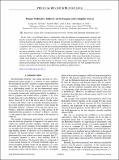| dc.contributor.author | Du, Liang | |
| dc.contributor.author | Chen, Qi | |
| dc.contributor.author | Barr, Aaron D. | |
| dc.contributor.author | Barr, Ariel R. | |
| dc.contributor.author | Fiete, Gregory | |
| dc.date.accessioned | 2019-03-14T19:15:54Z | |
| dc.date.available | 2019-03-14T19:15:54Z | |
| dc.date.issued | 2018-12 | |
| dc.date.submitted | 2018-08 | |
| dc.identifier.issn | 2469-9950 | |
| dc.identifier.issn | 2469-9969 | |
| dc.identifier.uri | http://hdl.handle.net/1721.1/120969 | |
| dc.description.abstract | In this work, we use Floquet theory to theoretically study the influence of monochromatic circularly and linearly polarized light on the Hofstadter butterfly—induced by a uniform perpendicular magnetic field—for both the kagome and triangular lattices. In the absence of laser light, the butterfly has a fractal structure with inversion symmetry about magnetic flux, ϕ = 1/4,3/4, and reflection symmetry about ϕ = 1/2. As the system is exposed to an external laser, we find that circularly polarized light deforms the butterfly by breaking the mirror symmetry at flux ϕ = 1/2. By contrast, linearly polarized light deforms the original butterfly while preserving the mirror symmetry at flux ϕ = 1/2. We find the inversion symmetry is always preserved for both linearly and circularly polarized light. For linearly polarized light, the Hofstadter butterfly depends on the polarization direction. Further, we study the effect of the laser on the Chern number of the lowest band in the off-resonance regime (laser frequency is larger than the bandwidth). For circularly polarized light, we find that low laser intensity will not change the Chern number, but beyond a critical intensity the Chern number will change. For linearly polarized light, the Chern number depends on the polarization direction. Our work highlights the generic features expected for the periodically driven Hofstadter problem on different lattices. | en_US |
| dc.description.sponsorship | United States. Army Research Office (Grant W911NF-14-1-0579) | en_US |
| dc.description.sponsorship | National Science Foundation (U.S.) (Grant DMR-1507621) | en_US |
| dc.description.sponsorship | National Science Foundation (U.S.) (Grant DMR-1720595) | en_US |
| dc.publisher | American Physical Society | en_US |
| dc.relation.isversionof | http://dx.doi.org/10.1103/PhysRevB.98.245145 | en_US |
| dc.rights | Article is made available in accordance with the publisher's policy and may be subject to US copyright law. Please refer to the publisher's site for terms of use. | en_US |
| dc.source | American Physical Society | en_US |
| dc.title | Floquet Hofstadter butterfly on the kagome and triangular lattices | en_US |
| dc.type | Article | en_US |
| dc.identifier.citation | Du, Liang et al. "Floquet Hofstadter butterfly on the kagome and triangular lattices." Physical Review B 98, 24 (December 2018): 245145 © 2018 American Physical Society | en_US |
| dc.contributor.department | Massachusetts Institute of Technology. Department of Physics | en_US |
| dc.contributor.mitauthor | Fiete, Gregory | |
| dc.relation.journal | Physical Review B | en_US |
| dc.eprint.version | Final published version | en_US |
| dc.type.uri | http://purl.org/eprint/type/JournalArticle | en_US |
| eprint.status | http://purl.org/eprint/status/PeerReviewed | en_US |
| dc.date.updated | 2018-12-26T18:00:28Z | |
| dc.language.rfc3066 | en | |
| dc.rights.holder | American Physical Society | |
| dspace.orderedauthors | Du, Liang; Chen, Qi; Barr, Aaron D.; Barr, Ariel R.; Fiete, Gregory A. | en_US |
| dspace.embargo.terms | N | en_US |
| mit.license | PUBLISHER_POLICY | en_US |
